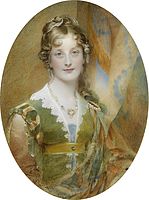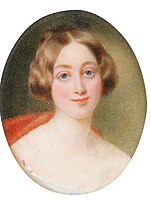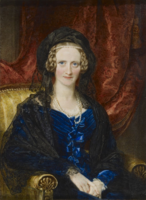William Charles Ross
Sir William Charles Ross
Life and work
At an early age young Ross showed great ability in art, and in 1807 received the "lesser silver palette" from the
For some years afterwards his exhibited works were mainly of a classical character, and in 1825 he sent to the Royal Academy a large picture representing "Christ casting out Devils". In 1810, he again received a silver medal, and 20 guineas, from the Society of Arts, for an original drawing of "Caractacus brought before Claudius Cæsar"; in 1811, the silver medal and twenty guineas for an original drawing of "Samuel presented to Eli"; in 1816, the gold Isis medal for an original portrait of the Duke of Norfolk, president of the society; and in 1817, the gold medal for an original historical painting, "The Judgment of Brutus".[1]
At the age of twenty he became an assistant to

He was elected an associate of the Royal Academy in 1838, and in 1843 a royal academician, and was knighted on 1 June 1842. The Westminster Hall competition of 1843 led him to turn his hand once more to historical composition, and he sent a cartoon of "The Angel Raphael discoursing with Adam", which was awarded an extra premium of £100.
He continued to hold a preeminent position amongst miniature-painters until 1857, when he was struck down by paralysis while engaged on portraits of the
Family

Hugh Ross (1800–1873), younger brother of Sir William Charles Ross, was also a miniature-painter, and exhibited at the Royal Academy from 1814 to 1845. Magdalene Ross (1801–1874), a sister, who likewise practised the same branch of art, exhibited at the Royal Academy between 1820 and 1856; she married Edwin Dalton, a portrait-painter.
Legacy
Ross's portrait was painted by Thomas Henry Illidge, and engraved on wood for The Art Journal of 1849; a miniature was also painted by his brother, Hugh Ross. An exhibition of miniatures by him was held at the Society of Arts early in 1860, and in June his remaining works were sold by the auctioneers Christie, Manson & Woods.[1]
Ross held the same position with respect to miniature-painters that Thomas Lawrence did among portrait-painters. Writing for the Dictionary of National Biography, Robert Edmund Graves noted that "others have surpassed him in power of expression, but in refinement, in purity of colour, and in truth, he had no rival. His portraits of men are marked by a strong individuality, while his women charm by their grace and delicacy".[1]
Gallery
-
Jane Digby, Lady Ellenborough (1807-1881)
-
Zénaïde Clary, Princesse et Duchesse de Wagram
-
Feodora, Princess of Hohenlohe-Langenburg (1807-1872), sister of Queen Victoria of the United Kingdom (1819-1901).
-
King Ferdinand II of Portugal, 1852
-
Ernest II, Duke of Saxe-Coburg-Gotha(1818-1893) when Hereditary Prince of Saxe-Coburg-Gotha.
References
- ^ a b c d e f g h "Ross, William Charles". Dictionary of National Biography. London: Smith, Elder & Co. 1885–1900.
- Royal Collection Trust. Inventory no. 420385.
- ^ Cansick, Frederick Teague (1872). The Monumental Inscriptions of Middlesex Vol 2. J Russell Smith. p. 141. Retrieved 15 October 2021.
- ^ "Portrait of Magdalena Dalton, born Ross". Paintings & Drawings. Victoria and Albert Museum. Retrieved 14 October 2007.
External links
- 4 artworks by or after William Charles Ross at the Art UK site
- Works by William Charles Ross at Faded Page (Canada)
- W C Ross online (Artcyclopedia)
- W C Ross - biography (London atelier of representational art)
- Profile on Royal Academy of Arts Collections






